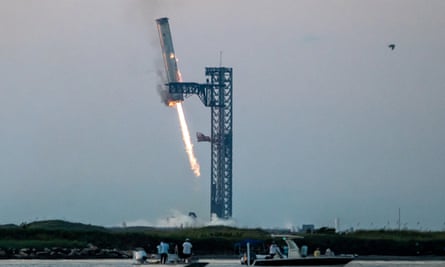Elon Musk’s huge rocket sets off on test flight before upper stage splashdown and explosion in Indian Ocean
Ian Sample and agenciesSun 13 Oct 2024 13.25 EDTFirst published on Sun 13 Oct 2024 09.31 EDTShareElon Musk’s SpaceX achieved a significant milestone on Sunday by catching the massive booster stage from its Starship rocket in a pair of robotic arms as it fell back to the company’s launchpad in southern Texas.
The historic feat, which drew praise from astronauts and space experts, topped a successful fifth test flight for the uncrewed Starship, which blasted off from the Boca Chica starbase at 7.25am local time (1325 BST) on Sunday.
As the rocket’s 71-metre (233ft) Super Heavy booster separated 40 miles (65km) above the Earth, the upper stage pushed on to an altitude of nearly 90 miles, looping around the planet at 17,000 mph before splashing down in the Indian Ocean as planned.
SpaceX staff erupted in cheers and applause as the falling booster reignited three of its Raptor engines, slowed its rapid descent and swung towards the “mechazilla” launch tower, where it was held fast by the mechanical arms, labelled “chopsticks”.
It is the first time SpaceX has attempted the bold manoeuvre, one it sees as crucial to its goal of developing fully reusable rockets capable of ferrying humans, scientific equipment and supplies to the moon and onwards to Mars.
“Are you kidding me?” said Dan Huot, SpaceX’s communications manager, who was left shaking at the spectacle. “What we just saw, that looked like magic.”
“This is a day for the engineering history books,” added Kate Tice, a quality systems engineer at SpaceX headquarters in Hawthorne, California.
 View image in fullscreenStarship’s booster is grappled at the launch pad. Photograph: Sergio Flores/AFP/Getty ImagesMusk says humans can be on Mars in four years. Many laugh, but some see purposeRead moreThe rest of Starship re-entered Earth’s atmosphere horizontally, with onboard cameras showing a smooth, pinkish-purple plasma covering the ship’s Earth-facing side. The ship’s hot side is coated with 18,000 heat-shielding tiles that were improved since SpaceX’s last test in June, when Starship completed its first full test flight to the Indian Ocean but suffered tile damage that made its re-entry difficult.
View image in fullscreenStarship’s booster is grappled at the launch pad. Photograph: Sergio Flores/AFP/Getty ImagesMusk says humans can be on Mars in four years. Many laugh, but some see purposeRead moreThe rest of Starship re-entered Earth’s atmosphere horizontally, with onboard cameras showing a smooth, pinkish-purple plasma covering the ship’s Earth-facing side. The ship’s hot side is coated with 18,000 heat-shielding tiles that were improved since SpaceX’s last test in June, when Starship completed its first full test flight to the Indian Ocean but suffered tile damage that made its re-entry difficult.
This time, Starship appeared more intact upon reigniting one of its six engines to position itself upright for the ocean landing. The SpaceX live stream showed the rocket splashing down in the night-time waters off Australia’s coast, then toppling on its side, concluding its test mission.
A separate camera view from a vessel near the splashdown site then showed the ship exploding into a vast fireball. It was unclear whether the explosion was a controlled detonation or the result of a fuel leak. Musk said the ship landed “precisely on target!”
Commenting on SpaceX’s successful capture of the Starship booster, Chris Hadfield, a Canadian former astronaut, wrote on X: “There was an enormous step forward in human capability today. Makes me even more excited for our collective future. Congratulations to all at SpaceX!”
SpaceX launches Starship rocket and catches booster in giant metal arms
Related Posts
Why did the -trilogy- of red performing arts in Yinan, Shandong become so popular-
On October 15, a vibrant scene unfolded in Changshanzhuang Village, located in the Ma Muchi Township o
Follow the general secretary’s inspection footsteps|Look at Xiamen
**Interviewer:** Can you tell us about Xiamen and its significance?**Interviewee:** Xiamen, historically know